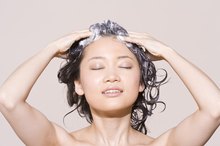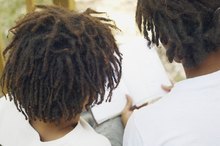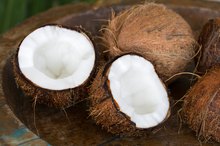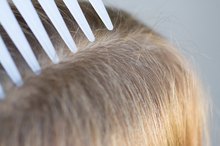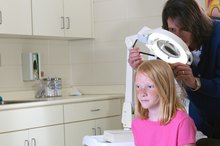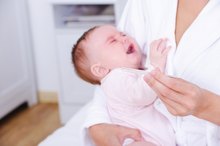What Bugs Infest the Human Hair?
Bugs that infest the human hair are known as lice 3. These small insects are parasites to the scalp that feed and reproduce in your hair. Not only are these bugs extremely uncomfortable, but they can spread to your friends and neighbors as well. Learning about lice and how to treat them will prevent an outbreak and can help you prevent infestation in the future.
About Lice
Lice are small, six-legged insects which live in human hair and feed off of human blood. A single lice, known as a louse, can live up to 30 days and produce 100 nits (eggs). Nits are secured to the base of a hair shaft by a glue-like substance and appear as whitish-yellow ovals. It takes approximately seven to 10 days for the eggs to hatch and then another seven to 10 days for the louse to fully mature and continue reproducing. When full grown, the lice will appear as dark sesame seeds.
- Lice are small, six-legged insects which live in human hair and feed off of human blood.
- A single lice, known as a louse, can live up to 30 days and produce 100 nits (eggs).
Symptoms of Lice
The Effects of Dandruff Shampoo on Lice
Learn More
Often the first sign of lice will be an excessively itchy scalp. Itching will be focused around the ears and the nape of the neck. Look through your hair using a fine-toothed comb or a toothpick and look for signs of the whitish-yellow eggs or black, sesame seed looking adults. Lice will not always appear black or brown, as the younger ones are generally clear in color. As they age and fill will blood their color will darken as well. If you are checking your hair in the beginning stages of a lice outbreak, you may have a hard time finding them because of their small size and light color. Even so, you should begin treatment immediately or see your doctor.
- Often the first sign of lice will be an excessively itchy scalp.
- Look through your hair using a fine-toothed comb or a toothpick and look for signs of the whitish-yellow eggs or black, sesame seed looking adults.
How to Treat Lice
If you have an infected child, begin by notifying the school where they attend. If your child has lice, then it is very likely that other children at the school have contracted them as well. The school can conduct lice checks based on your notification. Purchase lice shampoo and a lice comb. Frequently wash your child’s hair with the shampoo, which kills the lice on contact, and then brush the hair with the lice comb, which is effective in removing the lice and the remaining nits.
- If you have an infected child, begin by notifying the school where they attend.
- Frequently wash your child’s hair with the shampoo, which kills the lice on contact, and then brush the hair with the lice comb, which is effective in removing the lice and the remaining nits.
How to Prevent Lice
How to Treat Hair Mites in Humans
Learn More
Lice prevention is fairly straightforward. Because lice are crawling bugs, you do not have to worry about them jumping or flying onto you. Simply avoid sharing clothes, hats, brushes and headbands with other people. If you have just gotten over a lice outbreak, wash all of your clothes, hats, brushes and blankets as they can survive on these surfaces for a short period of time and pose threat of reinfestation.
- Lice prevention is fairly straightforward.
- Because lice are crawling bugs, you do not have to worry about them jumping or flying onto you.
Related Articles
References
- Kidzworld: How to deal with Head Lice
- Headlice.org: Lousology 101
- Rid: All about Lice-What are the Symptoms of Lice?
- Meister L, Ochsendorf F. Head Lice: Epidemiology, Biology, Diagnosis, and Treatment. Deutsches Ärzteblatt International. 2016;113(45):763-772. doi:10.3238/arztebl.2016.0763
- Centers for Disease Control and Prevention. Head Lice: Frequently Asked Questions (FAQs). Updated July 17, 2019.
- Devore CD, Schutze GE. Head Lice. Pediatrics. 2015;135(5). doi:10.1542/peds.2015-0746
- Barker SC, Altman PM. A Randomised, Assessor Blind, Parallel Group Comparative Efficacy Trial of Three Products for the Treatment of Head Lice in Children--Melaleuca Oil and Lavender Oil, Pyrethrins and Piperonyl Butoxide, and a "Suffocation" Product. BMC Dermatol. 2010 Aug 20;10:6. doi:10.1186/1471-5945-10-6
- Abdel-Ghaffar F, Al-Quraishy S, Al-Rasheid KA, Mehlhorn H. Efficacy of a Single Treatment of Head Lice With a Neem Seed Extract: An in Vivo and in Vitro Study on Nits and Motile Stages. Parasitol Res. Published June 11, 2011. doi:10.1007/s00436-011-2484-3
Writer Bio
Nicki Callahan began her literary career in 1989. Her work has appeared in "The Charlotte Observer," "The Patriot Ledger," "The Wasatch County Courier," "Utah Homes & Garden Magazine" and "The Retired Officer Magazine." Callahan studied English literature and creative writing at the University of California, Los Angeles and the University of Utah.

